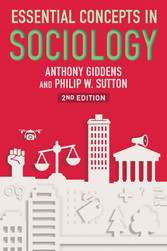
Essential Concepts in Sociology
von: Anthony Giddens, Philip W. Sutton
Polity, 2017
ISBN: 9781509516704
Sprache: Englisch
240 Seiten, Download: 351 KB
Format: EPUB, auch als Online-Lesen
2
Doing Sociology
Ideal Type
Working Definition
The researcher’s ‘pure’ construct of a social phenomenon, emphasizing only some of its main aspects, which is used to approach the similarities and differences in concrete, real-world cases.
Origins of the Concept
The concept of the ideal type was devised by Max Weber as part of his method for studying social action as a form of sociology. For Weber, understanding and explaining social life was not possible using the same methods as the natural sciences. Human beings, unlike other beings in the natural world, create a meaningful environment, and to understand their individual actions we have to set these within the context of that social environment. Of course, people create organizations and social institutions, which some sociologists see as their main object of research, but Weber ([1904] 1949) argued that a full account of social phenomena has to be understandable at the level of individual action. This approach to sociology is known as Verstehen, and Weber used it to explore the origins and key aspects of capitalism and its relationship to religious belief, the different types of economic life across societies, types of authority and leadership, and forms of organization in different historical periods. Constructing ideal types was an important element of Weber’s method that allowed him to bring together the macro and micro levels of sociological analysis.
Meaning and Interpretation
Ideal types are ‘constructs’ – that is, they are created by researchers on the basis of criteria derived from their interest in a particular social phenomenon. For example, we could construct an ideal type of socialism, democracy, cybercrime, consumer society or moral panic. However, in making the construct, we do not aim to combine as many aspects of the phenomenon as possible in order to produce an accurate depiction of it. Because, Weber argued, sociology cannot replicate the experimental methods of the natural sciences, we need to find other ways of gaining valid knowledge of society, and the ideal type is one useful tool which helps us do that.
For example, if we want to understand the ‘new terrorism’ of al-Qaeda networks and the self-styled Islamic State (Daesh), we can identify some typical aspects from our observations – perhaps their global connections, loose organizational forms, disparate aims and preparedness to use extreme violence against civilian targets. Then we can create our ideal type around these central features. Of course, real cases of the new terrorism will include more than just these elements and, in some cases, one or more elements may be absent while others are more prominent. For example, Daesh actions in Syria and Iraq involved creating an effective army, rather than a loose network, that succeeded in temporarily taking and holding territory. However, in creating an ideal type we are intentionally creating a one-sided model, a pure form, which probably does not or never could exist in reality. Those people, cells and organizations involved in the new terrorism may actually behave in ways that diverge from our ideal type. But the point of the exercise is to highlight a logically derived form of the new terrorism which will enable us to compare it with older forms and pick out significant similarities and crucial differences among real-world cases much more easily. Ideal types are heuristic devices – research tools that sociologists use to devise hypotheses and make comparisons.
An ideal type is akin to a standpoint from which we can observe the social world, a reference point that enables the researcher to begin to formulate some realistic questions about the phenomena in question. Hence, ideal types can never be said to be true or false, and it was not Weber’s intention that they should be tested against empirical cases in the same way that might be the situation with scientific hypotheses, and then falsified if negative instances are found. Their value lies in the research that flows from them and the contribution they make to our understanding. If ideal types fail to give us any better grasp of reality or just do not work in generating further research questions and studies, they will simply be abandoned as, simply and literally, useless.
Critical Points
Weber’s critics see ideal types as being of limited use in sociology. Norbert Elias, for instance, caustically remarked that it was strange to think we should spend our time constructing ideal types when we can study ‘real types’ or empirical cases instead. This criticism seems a good one, though we have to remember that ideal types are meant to be part of the preliminary stages of research which will then develop into formal empirical studies.
A further problem with ideal types lies more in the way they are used than in the concept itself. In particular, what starts out as a heuristic device to aid understanding can quickly become a real characterization that needs to be defended. In short, a fictitious ideal type comes to be treated as though it represents a real social phenomenon and, instead of aiding understanding, becomes an obstacle to it. Talcott Parsons observed this slippage even in Weber’s own work on ‘capitalism’, in which he moves between the construct and the unique historical form. In Parsons’s view, the ideal type is useful when identifying general aspects of social phenomena for comparative studies, but much less so when investigating unique historical periods and cultures, which demand detailed empirical investigation.
Continuing Relevance
Ideal types continue to be used in sociology, especially when apparently new phenomena emerge. Sociologists researching ‘new’ social movements (NSMs), the ‘new’ terrorism or ‘new’ wars have all constructed ideal types of the phenomena they want to study, which they then use to guide their research into specific cases. For instance, theories of NSMs in the 1980s portrayed them as relatively loosely organized, involving mainly the new middle classes, which employed symbolic direct actions to bring new issues, such as the environment, to public attention. This ideal typical model was then subject to merciless critique, as historical sociologists such as Craig Calhoun (1993) had little difficulty finding ‘new social movements’ back in the nineteenth century. However, without the initial ideal type to guide the later research effort, we may not have arrived at the present more realistic understanding of the new movements. This is a good example of the continuing value of the ideal type as a heuristic tool that stimulates research and helps us gain a better understanding of social phenomena.
In a critique of the type of class analysis conducted by researchers looking to explore the Goldthorpe class scheme, Prandy (2002) notices some similarities with Weberian ideal types and their problems. Many empirical studies of social class necessarily have to summarize a whole series of characteristics into ideal-typical class categories. In a sense this is a similar procedure to the generation of stereotypes in social life: in both cases, the resulting types are inevitably oversimplifications that are not intended to represent real-world class groups accurately. Because of this, Prandy’s concern is that theories built on this kind of analysis are effectively insulated from empirical falsification. His article explores a potential alternative to this standard method.
References and Further Reading
Calhoun, C. (1993) ‘“New Social Movements” of the Early Nineteenth Century’, Social Science History, 17(3): 385–427.
Hekman, S. J. ([1983] 2006) Weber, the Ideal Type and Contemporary Social Theory (Notre Dame, IN: University of Notre Dame Press).
Lister, C. R. (2015) The Islamic State: A Brief Introduction (Washington, DC: Brookings Institution Press).
Parkin, F. (2009) Max Weber (rev. edn, London: Routledge), esp. chapter 1.
Prandy, K. (2002) ‘Ideal Types, Stereotypes and Classes’, British Journal of Sociology, 53(4): 583–601.
Weber, M. ([1904] 1949) ‘Objectivity in Social Science and Social Policy’, in E. A. Shils and H. A. Finch (eds), The Methodology of the Social Sciences (New York: Free Press), pp. 50–112.
Qualitative/Quantitative Methods
Working Definition
A basic distinction between those approaches to research that look for in-depth knowledge by tapping into the subject’s reasoning and decision-making processes (qualitative) and those that make extensive use of measurement to quantify social phenomena (quantitative).
Origins of the Concept
Quantitative research was central to sociology from the discipline’s inception. Durkheim’s use of official statistics to quantify suicide rates and make comparisons across societies is typical of the kind of technique sociologists adopted. Given the desire in the nineteenth century to establish sociology as the ‘science of society’, it is not surprising that sociologists turned to quantitative methods, which held out the promise of accurate and reliable measurement. Such methods also offered the potential for comparative and historical studies which could yield...










